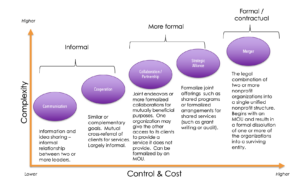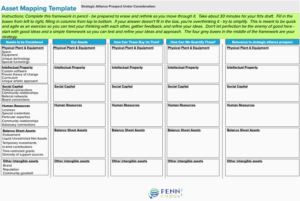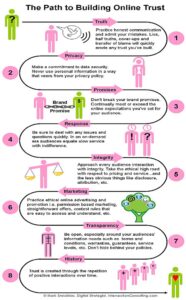By Molly Penn
Nonprofit organizations are part of an ecosystem of our social safety net (and we include arts organizations in that category). Nonprofits pick up where government support and protection leaves off. What we find over and over in our work is the importance of adopting a relational approach to working in communities. Nonprofits are not islands. They don’t exist in a vacuum. They can no longer afford to look at each other as competitors for funding. The time has come to rediscover the importance of social capital in mission work – having a strong network for partnerships and collaborations.
We hear these terms “partnerships and collaborations” and we don’t always know what that means specifically. So it can be helpful to frame them in terms of the whole spectrum of collaborative activity that organizations engage in.

There are the informal ways of collaborating: communication and cooperation. Most organizations probably do this without thinking about it. This form of collaboration is simple and straight-forward, and has the least amount of cost to your organization while also being the type you can least control the least. Meaning there are no explicit rules and no money is at stake.
There are more formal methods of collaborating – collaboration, partnership or strategic alliances. These are more formalized forms of collaboration where two or more organizations come together around a shared endeavor that is mutually beneficial. This could look like referrals if your missions are complementary, or joint programming, or shared back office services. These are a bit more complex than communication & cooperation and typically require being memorialized in a Memorandum of Understanding, or an MOU – which means there is an attorney involved so it has more cost and gives you greater control over the collaboration.
In this article, we’re focusing on that second set – collaborations and partnerships.
Collaboration – a mutually-beneficial and well-defined relationship entered into by two or more organizations to achieve common goals. The relationship includes a commitment to mutual relationships and goals; a jointly developed structure and shared responsibility; mutual authority and accountability for success; and sharing of resources and rewards.
This is the dictionary definition of a collaboration – notice the words mutually-beneficial and well-defined. Collaborations are not casual, they are intentional and involve a mutual degree of accountability, responsibility and resources.
Start By Assessing Your Readiness
If you are considering entering into a partnership or collaboration with another organization, we advise that you start by doing your own work first. The more you know your own organization and what you want from, and have to give to the collaboration, the better. It helps to have:
- A clearly defined purpose for the collaboration – what do you hope to accomplish?
- Commitment at every level of your organization
- Sufficient time to conduct the negotiations and structure the collaboration
- A welcoming culture – cultural compatibility is an aspect of collaborations that is often overlooked, and particularly now as organizations are taking public positions on racism, it is vital
- Adequate funding – there may be unanticipated expenses that come up along the way, like facilitated meetings and such, so it helps to have sufficient funding that you’re not going to get stuck part way through.
Take Stock of Your Capacity
Next it is important to take stock of your organization’s current capacity, and how it is situated in the environment. The quickest way to do this is to do a Strengths, Weaknesses, Opportunities & Threats analysis. This involves getting key stakeholders with different vantage points together to list the things you do better than others, not as well as others, and the changes in the environment that are threatening you or providing you with opportunities. Having a good understanding of these factors as you approach the idea of collaborations or partnerships helps you understand both what you bring to the table and what you need from the collaboration.

We also advise you to spend time taking stock of your assets. These are things you bring to the collaboration or partnership that make you a desirable partner. They also help you negotiate from a position of strength, where you are clear about what you have to offer to a prospective partner or collaborator. We like to use a tool like this to ensure our clients are thinking through all the various types of assets, from real property, to financial assets, to intellectual property and social capital. Finally, a last piece of the internal preparation might include using a MacMillan Matrix to analyze your current programs. As you see across the top, you score your programs on a number of criteria:
 “Attractiveness” – meaning how easy it is to attract resources
“Attractiveness” – meaning how easy it is to attract resources- Fit with Mission
- Competitive Position
- Alternative Coverage – meaning people can find similar offerings elsewhere in the community.
Then the matrix helps you understand whether some programs would be best served by finding a partner. Once you do your internal assessment and preparation, then it is time to look outside yourself to identify prospective partners.
Consider Your Goals
It is important, as we noted earlier, to be clear with ourselves about what you are seeking to accomplish through a collaboration or partnership. How will it help your ability to deliver on your mission? How will it help your constituents have access to greater or more complementary programs? This might be a conversation to have with your senior staff, and/or your board.
Then you are ready to begin looking around your environment to compile a list of prospective partners. Often, we hear from organizations who say we’ve been approached by another organization to partner with them, or we want to approach organization X to partner with them. When you have an identified partner, you might assess why you want to partner, and then compile a list of prospective partners rather than putting all your eggs in one basket. Once you figure out what purpose a partnership or collaboration will serve, it is much more efficient to have several possible partners in mind.
Also, it is helpful to think outside your typical box when you think about possible partners. They don’t all have to have similar missions, they could be complementary.
Partnership Discussions
Once you have your list of prospective partners, you can rank them and then you are ready to begin discussions with them. We can’t stress enough that while we are advising you to be systematic about preparing for a collaboration or partnership, the actual discussions are the time to slow down and build authentic relationships with these prospective partners.
- You will want to evaluate their values and how aligned they are with yours.
- You will want to assess their reputation and how that will affect your organization.
- You’ll also want to think about their brand and how it aligns with you brand. This is a trust building phase, so leave yourselves time to explore, and build openness and transparency

This little graph is a good cheat sheet to guide you on this path to building trust – which is the foundation for any good partnership.
If your aim at this point in the process is building trust, consider what you will need to know to feel confident about your potential partner. Consider what you are comfortable disclosing at this point in the process in order to help them have confidence in you?
Managing Potential Conflicts
In the course of your discussions with potential partners, there may be conflicts that arise – communication conflicts, structural conflicts, relationship conflicts, conflicts of interest, or of values.
| Type of Conflict | Causes & Signs | Possible Solutions |
| Communication Conflicts | · Not enough information being exchanged
· Inaccurate information being exchanged · Unclear communication leading to misunderstandings · Making of assumptions by one or more parties · Language barriers |
· Check interpretation of information to ensure consistency
· Clearly define terms · Work to clarify assumptions |
| Structural Conflicts | · Insufficient or imbalanced structures, processes or systems
· Time limitations |
· Carefully examine the context of the conflict
· Adjust deadlines or timelines to alleviate pressure · Revisit the design of the process to ensure it is favorable to all |
| Relationship Conflicts | · Inconsistent or unrealistic expectations, abuse or gross imbalance of power
· Judgements made based on stereotypes, sexism or racism · Unrealistic perceptions (see communication conflicts) · Personal conflicts · Low comfort level between or among partners |
· Try to limit impact of emotions and personal relationships
· When conflicts arise, avoid defensiveness, judgment, and ask other to do the same · Show concern for the points of view of all involved · Ensure power is balanced or deemphasized at the collaboration table |
| Interest Conflicts | · Qualitative or quantitative differences between partners in interests, needs or perspectives | · Encourage compromise and accommodation
· Seek and emphasize common commitments · Ensure power is balanced or deemphasized at the collaboration table |
| Value Conflicts | · Collaborative partners having opposing values, points of view, philosophies or beliefs (can result from cultural differences or considerable differences in missions) | · Seek and point out shared goals and values
· Acknowledge and respect value differences |
The point is not to get discouraged at the first sign of conflict, but to see that as a moment to take a breath and lean into better understanding the conflict to see if it is navigable.
Depending on the seriousness and the stakes involved in your partnership and collaboration discussions, you may want to pay attention to these other factors as well. Doing everything you can to ensure it is a neutral setting that does not favor one organization over another may be helpful, particularly when there are high stakes involved – maybe this pertains to one of your strongest programs, or maybe it has the potential to affect your brand. Those might be situations where you’ll want a sense of neutrality and an honest read of your self-interests.
Getting It Down On Paper
When you have reached agreement on the core aspects of the collaboration or partnership, it will be important to memorialize your agreements in an MOU. The MOU gives all the pertinent details so there are no questions later in the process about who was responsible for what and to whom, how long the partnership/collaboration will last, and most importantly how you will settle any disputes that might arise. It is important to anticipate these things in order to lower the temperature if and when they do arise. Knowing you’ve considered that as an option, takes away the element of surprise and betrayal when they crop up unexpectedly.

